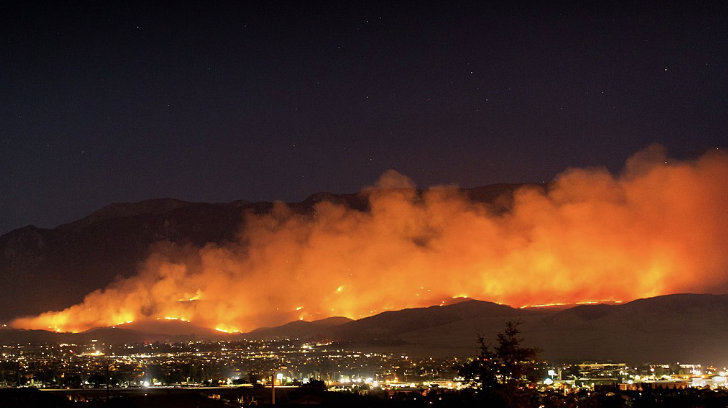The Apple Fire burns July 31, 2020 in Beaumont, California, becoming one of thousands in California’s climbing rates of wildfires. Students from California remember their encounters with wildfires and how they have changed over the last few decades.
Californian students look back on decades of wildfires
In the summer of 2020, near Lake Tahoe, Rowan Hamilton (’26) was forced to evacuate and end summer camp early because of a nearby fire.
While Hamilton said “it doesn’t make me love California any less,” she said this emergency made her more aware of California’s wildfire issue and its potential danger.
“It’s just in the back of my head whenever I go back, is that it is something that happens and it’s something that’s a risk when I’m living there,” Hamilton said.
Colette Brown (’23) moved to London from California two years ago and said wildfires have always been prevalent. However, she noticed they seemed to be escalating in severity in her last couple of years.
“It started to just kind of feel like an annual thing of like, ‘Oh, this is when the fires are starting up again,’” Brown said. “It was a little hard to avoid being affected by it. That was the first time that I had school canceled because the air quality wasn’t good enough.”
Rising rates
The number of wildfires per year rose consecutively throughout the 2010s along the West Coast, according to the New York Times. They identified poor forest management practices and climate change’s effects as the primary causes of the increasing rates.
Brown said while wildfires have always been an issue in California, climate change seems to be causing the rising rates.
“There’s definitely been an increase of it because of climate change,” Brown said. “We haven’t really been getting as much rainfall, but California has always been a place where I think fires are kind of common.”
It feels very apocalyptic because the skies get red, and everything starts burning down.
— Oliver Preiser ('23)
Although Oliver Preiser (’23) moved away from Los Angeles when he was eight years old, he said he is still in touch with friends who describe the effects of wildfires in the city.
“I’ve heard horror stories, usually just that it feels very apocalyptic because the skies get red, and everything starts burning down,” Preiser said. “A lot of the time it’s caused because there’s a lot of like controlled fire stuff and it doesn’t go well and so it ends up burning down a lot more.”
The deadliest and most destructive fire in California, referred to as Camp Fire, occurred in 2018, according to the National Institute of Standards and Technology. Brown said since the event, fires have consistently been compared to Camp Fire.
Mitigation attempts
To improve California’s infrastructure to be “better suited” to fires and floods, Brown said the topic must stay relevant in the media.
“We do need to continue reporting on them because treating wildfire as just another sort of monotonous event isn’t really helpful to anything, especially considering that the increase in wildfires is like a product of climate change,” Brown said. “Ignoring it and brushing it under the rug is gonna not really help inspire any actual climate activism.”
Ignoring it and brushing it under the rug is gonna not really help inspire any actual climate activism.
— Colette Brown ('23)
Preiser said he recalls many drills, including earthquake drills, taking place when he was in elementary school in California, demonstrating how wildfire dangers are also prevalent within schools.
“California is very prepared for natural disasters, but I think they haven’t understood or at least didn’t understand how bad it would get,” Preiser said. “I’ve definitely been prepared from a very, very young age for natural disasters just because it’s on a fault line, and also, again, there are fires and natural disasters that happen all the time.”
According to the National Park Service, California has a distinctive chaparral terrain with the most flammable plants in the U.S. As a result, controlled burnings are conducted to prevent the vegetation from overtaking the brushland, resulting in more catastrophic wildfires.
Preiser said controlled burning might contribute to the destruction caused by fires as they tend to escalate from the dehydrated vegetation quickly.
“It’s obviously caused because of again, like, these controlled wildfires that aren’t very well done,” Preiser said. “Obviously just, like, an increasing climate, which leads to, like, thousands if not hundreds of thousands of species dying and a bunch of woods burning down because it’s all dry wood.”
Unique to California
While the topography contributes to the frequency of fires, Hamilton said it is sad that large areas may lose their rare features.
“It’s an absolutely incredible landscape, and it’s hard to think that that could just go away,” Hamilton said. “That’s hard to process.”
The patterns of wildfires in California’s history are increasing, and Preiser said this is a result of stagnating progress from people unaffected by California’s natural disasters.
“They’re getting really bad and they get worse every year, and that’s kind of the problem, that people don’t really acknowledge how bad it’s getting until it directly affects them,” Preiser said. “That’s something that happens in every crisis, that people don’t care until they’re at the forefront of it.”
They’re getting really bad and they get worse every year, and that’s kind of the problem, that people don’t really acknowledge how bad it’s getting until it directly affects them.
— Oliver Preiser ('23)
Ultimately, Hamilton said the only way to combat the issue of increasing wildfire rates is by addressing climate change.
“Initially, it’s just the climate and how dry it is with the droughts and different things,” Hamilton said. “Mitigating it, I’m not really sure what there is to do other than, I guess, larger global warming, like focusing on that as an issue.”


